Physical Address
304 North Cardinal St.
Dorchester Center, MA 02124
Leukemia is a group of hematologic malignancies derived from bone marrow cells, respectively. Although not as common as solid organ malignancies, the prevalence is estimated to be greater than 350,000 people with or in remission from leukemia in the United States. Leukemia is the most common cancer diagnosed in children; however, more than 90% of cases are diagnosed in adults. Leukemia can involve almost any organ, including the kidney. Kidney disease manifestations encompass a broad spectrum of disease: prerenal acute kidney injury (AKI), acute tubular necrosis (ATN), renovascular disease, parenchymal infiltration, obstruction, glomerulopathies, and electrolyte and acid-base abnormalities. Kidney injury may result from the underlying malignancy itself or as a secondary complication of therapy. The development of AKI in a patient with leukemia is of concern, as it may delay treatment, which in turn can affect prognosis and mortality. The overlap of the kidney and leukemia will be discussed here; chapters 16, 17, and 18 will discuss chemotherapies that can be used to treat leukemia and the resultant kidney injury that can develop from their use.
AKI in patients with leukemia is common. A study examining 349 patients with all forms of hematologic malignancy admitted to the intensive care unit demonstrated some form of AKI in 149 patients (43%). Of patients with AKI, 29% required renal replacement therapy, with a mortality rate of 72%. In 1411 intensive care unit patients, the diagnosis of a hematologic malignancy, leukemia or lymphoma, had the greatest risk for AKI (odds ratio [OR], 2.23), relative to other more common conditions seen in critically ill patients, including infection, cirrhosis, and cardiovascular disease. The presence of hematologic malignancy also had the greatest risk of death (OR 2.31) in all AKI patients. The approach to a patient presenting with AKI in the setting of leukemia involves assessing potential prerenal, intrarenal, and postrenal etiologies ( Table 37.1 ).
| Prerenal |
|
| Intrarenal |
|
| Postrenal |
|
Prerenal AKI is the most common kidney injury in leukemia. Poor oral fluid intake (78%), anorexia (64%), early satiety (50%), emesis (23%), and diarrhea (16%) lead to volume depletion and this can lead to a prerenal AKI. Volume depletion can be exacerbated by insensible losses and decreased effective circulating volume from comorbid conditions, such as cirrhosis or heart failure, or through the use of medications that affect kidney afferent and efferent tone, including renin-angiotensin blockade or nonsteroidal antiinflammatory medications (NSAIDs), or diuretics used for hypertension or to control peripheral edema. Prerenal AKI is often suspected based on the clinical course and history, and supported with physical examination findings that demonstrate signs of volume depletion, including hypotension and orthostatic blood pressure changes, tachycardia, flat neck veins, or poor skin turgor. Laboratory data that can be suggestive of a prerenal AKI include hyponatremia or hypernatremia (depending on the degree of free water loss relative to sodium and water loss) and an elevation in blood urea nitrogen (BUN) and serum creatinine, with the BUN to creatinine ratio generally greater than 20. The urinalysis may show an elevated specific gravity with possible ketonuria; if appetite has been exceedingly poor, urine electrolytes usually reveal a very low urine sodium (< 20 mEq/L) and low fractional excretion of sodium (< 1%), and the urine sediment is usually bland, with occasional hyaline casts or cellular elements. Treatment is supportive, with crystalloid expansion and removal of exacerbating factors that have led to the volume depletion.
In patients with leukemia, obstruction is relatively uncommon, but case reports have demonstrated tumor directly impeding ureteral outflow, extramedullary hematopoiesis causing retroperitoneal fibrosis, or more commonly nephrolithiasis from tumor lysis syndrome. In patients with obstructive AKI, hematuria and pyuria may also be present, and kidney ultrasound should demonstrate hydronephrosis, unless collecting system dilatation is prevented by fibrosis or if the patient has severe volume depletion ( Fig. 37.1 ). Treatment is supportive with immediate decompression of the obstruction with nephrostomy tubes to prevent ongoing and permanent injury.
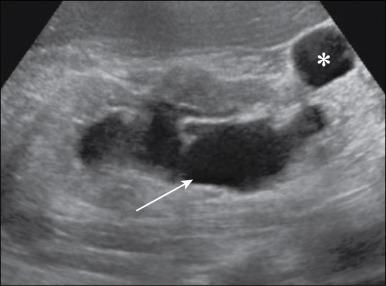
Intrarenal causes of kidney injury in leukemia can be grouped into ischemic and nonischemic ATN, tubulointerstitial disorders, renovascular disorders, and glomerulopathies. Hemodynamically mediated injury, caused by severe volume depletion, heart failure, or sepsis, and drug-induced injury are common with leukemia. However, it is critical to separate these processes from AKI directly caused by leukemia, as therapy is targeted towards the malignancy as opposed to general supportive measures, and prognosis depends on successful treatment of the underlying disease. Subsequent sections will focus on intrarenal AKI specific to hematologic malignancy.
Diagnosis of intrarenal AKI often relies on ancillary tests. Diagnostic imaging, which is involved in staging of leukemia, may be the first insight into kidney involvement. Computed tomography scan may show glomerulomegaly with diffuse bilateral enlargement, pointing to kidney infiltration ( Fig. 37.2 A ). Examination of the urine sediment is critical as its diagnostic potential is significant at a low cost. Renal tubular epithelial cells (RTEC) casts point towards ATN. White cells and white cell casts suggest an underlying malignant infiltration, acute interstitial nephritis, or severe pyelonephritis ( Fig. 37.2 B ). Dysmorphic red cells and red cell casts indicate a glomerular involvement. Kidney biopsy remains the gold standard in diagnosis and can help delineate all forms of intrarenal injury. Light microscopy with hematoxylin and eosin staining can demonstrate glomerular, tubulointerstitial, or vascular disorders. Special clonal cellular immunohistochemistry can elucidate the nature of the cells on the specimen. Immunofluorescence and electron microscopy can provide additional information on glomerular involvement. However, biopsy may be difficult in a patient with leukemia because of thrombocytopenia, which increases the risk of bleeding.
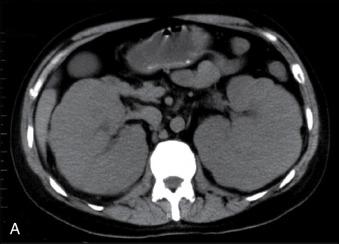
ATN is the most common cause of intrinsic AKI in leukemia. In a single center study, out of all patients with hematologic malignancy with AKI, 83% had ATN, with 96% of those patients experiencing sepsis and 88% receiving nephrotoxic medications. ATN can be detected through evaluation of the urinary sediment with the presence of granular casts or RTEC ( Fig. 37.3 A ). If the diagnosis is ambiguous, biopsy can be performed and would demonstrate acute tubular injury, as manifested as renal tubular cells with nuclear dropout, loss of brush border, and cytoplasmic vacuolization ( Fig. 37.3 B ). Disease specific etiologies of ATN are discussed later.
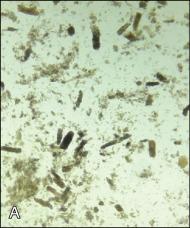
Lysozyme-induced tubular necrosis is a rare but documented cause of kidney injury in patients with leukemia. Lysozyme is a cationic enzyme stored in macrophages and monocytes that may be released to lyse bacterial cell walls. In certain leukemias, clonal expansion increases lysozyme production, which is freely filtered by the glomerulus and then reabsorbed by the proximal tubule cells. At high concentrations, as seen in leukemia, lysozyme induces direct tubular damage causing kaliuresis and proteinuria. High concentrations of urinary lysozyme, exacerbated by proximal tubule injury, which prevents reabsorption, can present as nephrotic range proteinuria, leading to a pseudonephrotic syndrome. When suspected, the protein can be measured with serum and urine protein electrophoresis revealing increased γ globulin levels, and confirmed with immunofixation to exclude monoclonal paraproteins. Treatment of the underlying malignancy will decrease lysozyme and improve kidney function.
Tumor lysis syndrome results from the release of intracellular potassium, phosphate, and nucleic acids from rapidly growing cancer cells. This can be spontaneous or the direct effect of chemotherapy. Purine nucleic acids are converted to xanthine and then to uric acid by xanthine oxidase. At high levels, uric acid crystals can precipitate in renal tubules, leading to direct tubular injury. This can be seen through evaluation of the urinary sediment demonstrating uric acid crystals in isolation or incorporated in casts ( Fig. 37.4 A and B ). In addition, uric acid is a vasoconstrictor that may exacerbate renal tubular damage, recruit proinflammatory cytokines to the renal interstitium, and delay recovery. Direct tubular injury can be seen by the presence of RTEC or granular casts in the urine sediment ( Fig. 37.4 C and D ). Prevention of tumor lysis syndrome with adequate hydration or direct xanthine oxidase inhibitors, such as allopurinol or febuxostat, is ideal. If uric acid levels increase despite these efforts, rasburicase, a recombinant urate oxidase that converts uric acid to allantoin, can be used.
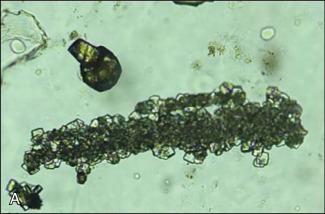
The kidney is the most common extrareticular and extrahematopoietic organ infiltrated by leukemia, with infiltration seen in 60% to 90% of patients with hematologic malignancy. Kidney dysfunction varies from asymptomatic increases in serum creatinine to severe AKI requiring dialytic support. The rate of infiltration parallels stage and grade of disease. In a series of 1200 autopsy cases, the prevalence of renal infiltration was 63% in chronic lymphocytic leukemia (CLL), 54% in acute lymphoblastic leukemia (ALL), 34% in chronic myeloid leukemia (CML), and 33% in acute myeloid leukemia (AML); however, the association with elevated serum creatinine and AKI was not reported. Although infiltration is possible, kidney failure primarily caused by leukemic infiltration is rare. AKI from infiltration is seen in only 1% of cases of all patients with acute leukemias and even less commonly in chronic leukemia.
Symptoms and signs that may be associated with infiltration include flank pain, hematuria, abdominal distension, or hypertension. Infiltration has to be bilateral in nature, as circulating cells have access to both kidneys, and enlargement is usually uniform throughout the superior, inferior, and mid-pole regions of the kidney. Renal biopsy is often useful in patients with leukemia who present with AKI in the setting of enlarged kidneys. Biopsy will reveal the extent of infiltration and underlying fibrosis both of which tend to influence prognosis ( Fig. 37.5 A ). Kidney injury resulting from infiltration is thought to be secondary to acute tubular compression and disruption of the renal microvasculature, from increased interstitial pressure leading to ATN. Biopsy may also help differentiate subtypes of leukemia and alter disease treatment ( Fig. 37.5 B ). Specific stains can be used to identify cellular markers of differentiation leading to targeted chemotherapy. Regression and improvement in kidney function should be prompt once therapy is initiated, even occurring within 2 to 3 days of therapy.
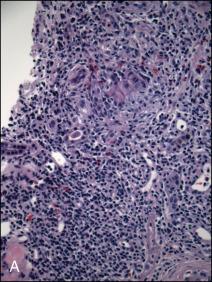
Become a Clinical Tree membership for Full access and enjoy Unlimited articles
If you are a member. Log in here